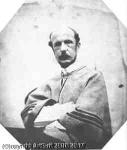Johann Moritz Rugendas
Johann Moritz Rugendas
Place: Augsburg
Born: 1802
Death: 1858
Biography:
Johann Moritz Rugendas was a German painter, famous for his works depicting landscapes and ethnographic subjects in several countries in the Americas, in the first half of the 19th century. Rugendas is considered "by far the most varied and important of the European artists to visit Latin America" whom Alexander von Humboldt influenced. Rugendas is also the subject of César Aira's 2000 novel, An Episode in the Life of a Landscape Painter.
Rugendas was born in Augsburg, then part of the Prince-Bishopric of Augsburg in the Holy Roman Empire, now Germany, into the seventh generation of a family of noted painters and engravers of Augsburg (he was a great grandson of Georg Philipp Rugendas, 1666–1742, a celebrated painter of battles), and studied drawing and engraving with his father, Johann Lorenz Rugendas II (1775–1826). From 1815-17, he studied with Albrecht Adam (1786–1862), and later in the Academy de Arts of Munich, with Lorenzo Quaglio II (1793–1869). When Rugendas was born, Augsburg was a Free Imperial City of the Holy Roman Empire, and after the Napoleonic Wars, it became in 1806 a city in the newly created Kingdom of Bavaria.
Inspired by the artistic work of Thomas Ender (1793–1875) and the travel accounts in the tropics by German naturalists Johann Baptist von Spix (1781–1826) and Carl von Martius (1794–1868), in the course of the Austrian Brazil Expedition, Rugendas arrived in Brazil in 1822, hired as an illustrator for Baron von Langsdorff's scientific expedition to Brazil. Langsdorff was the consul-general of the Russian Empire in Brazil and had a farm in the northern region of Rio de Janeiro, where Rugendas went to live with other members of the expedition.
In this capacity, Rugendas visited the Serra da Mantiqueira and the historical towns of Barbacena, São João del Rei, Mariana, Ouro Preto, Caeté, Sabará and Santa Luzia. Just before the fluvial phase of the expedition started (a fateful journey to the Amazon), he became alienated from von Langsdorff, left the expedition and was replaced by the artists Adrien Taunay and Hércules Florence. However, Rugendas remained on his own in Brazil until 1825, exploring and recording his many impressions of daily life in the provinces of Minas Gerais and Rio de Janeiro, and quickly the coastal provinces of Bahia and Pernambuco on his journey back to Europe. He produced mostly drawings and watercolors.
On his return to Europe between 1825 and 1828, Rugendas lived successively in Paris, Augsburg and Munich, with the aim of learning new art techniques, such as oil painting. There, he published from 1827 to 1835, with the help of Victor Aimé Huber, his monumental book Voyage Pittoresque dans le Brésil (Picturesque Voyage to Brazil), with more than 500 illustrations, which became one of the most important documents about Brazil in the 19th century.
He studied in Italy, but re-inspired by explorer and naturalist, Alexander Humboldt (1769–1859), Rugendas sought financial support for a much more ambitious project of recording pictorially the life and nature of Latin America; in his words "an endeavor to truly become the illustrator of life in the New World". In 1831 he traveled first to Haiti, and then to Mexico. In Mexico, he did drawings and watercolors of Morelia, Teotihuacan, Xochimilco, and Cuernavaca. He also began to use oil painting, with excellent results. Unfortunately, Rugendas was incarcerated and expelled from the country after he became involved in a failed coup against Mexico's president, Anastasio Bustamante, in 1834.[citation needed]
From 1834-44 he travelled to Chile, Argentina, Uruguay, Peru and Bolivia, and finally went back to Rio de Janeiro, in 1845. Well-accepted and feted by the court of Emperor Dom Pedro II, he executed portraits of several members of the royal court and participated in an artistic exposition. At the age of 44, in 1846, Rugendas departed for Europe.
From 1822-1825, as part of the Langsdorff expedition, Johann Moritz Rugendas depicted black people living in Brazil. Along with other ethnographic artists who worked in Brazil, like Jean-Batiste Debret, and François-August Biard, Rugendas is part of the tropical romanticism. This movement challenged the dichotomy between nature and civilization and considered places like colonial Brazil a harmonious environment to racial mixing.
Tropical romanticism was one of the elements that influenced the representations of black people made by Rugendas. According to Freitas, one type of illustration Rugendas used was the bust of black people of varied origins. This type of illustration details the physical characteristics of black men and women focusing on hairstyles, adornments, marks and scars, and types of nose, lips, and eyes, demonstrating the ethnographic purpose of these drawings. In the same lithograph, the artist depicts four or five busts of men and women to compare differences and similarities among nations of origin, but also to identify different degrees of civilization. He identified more savage people depicting them with skin marks and deformities and normally without clothes. On the other hand, criollos were represented wearing clothes and jewelry which meant a step forward toward civilization if compared with black Africans. Rugendas celebrated black people born in Brazil, who were more polished and benevolent than Africans.
More...
Wikipedia link: Click Here














